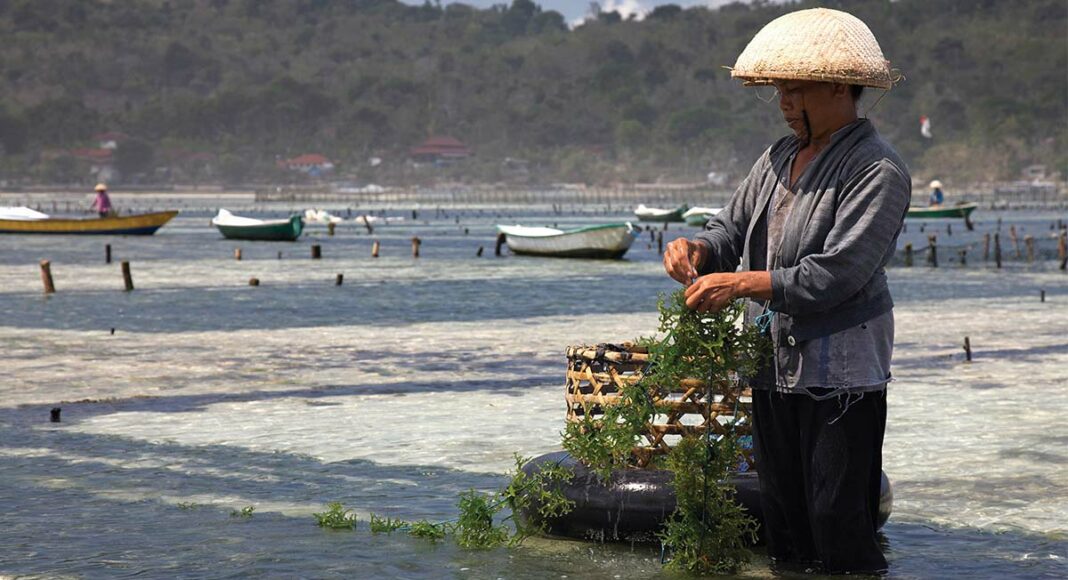Agriculture played a defining role in human history, but many believe that it’s aquaculture that holds the key to our future.
Seaweed is already a $5.6 billion global industry, according to the Food and Agricultural Organization of the United Nations, and it appears to be rapidly growing. Beyond a myriad of commercial uses—like food additives, fertilizers and cosmetics—seaweed demand is also increasing due to its nutritional properties. A superfood of the sea, it’s loaded with vitamins A, B, and C, as well as micronutrients like calcium, iron, manganese, zinc, and iodine. It is also a rich source of antioxidants, and even contains a type of fiber called alginate that may block fat absorption in the gut and lead to better weight management.
A 2003 study published in the journal Endocrine Practice found that kelp supplementation increased levels of the thyroid-stimulating hormone (TSH), essential in regulating metabolism. And a 2008 study published in Nutrition Research and Practice looked at patients with type 2 diabetes, and found that taking a seaweed supplement led to better blood sugar control, lower triglyceride levels, higher HDL (healthy cholesterol), and even greater antioxidant enzyme activity.
Although commercial-scale seaweed farming has yet to take off on the West Coast, those in favor of it see it as rife with potential, and a boon for entrepreneurs and disenfranchised fisherman whose usual fish stocks have declined or disappeared. For one, seaweed is one of the fastest-growing organisms on Earth, with some species growing around two feet per day. Many farmers also employ what’s known as integrated multi-trophic aquaculture, where they farm shellfish like mussels, scallops, oysters, and clams in symbiosis with the seaweed—each one fed and fertilized by the other’s byproducts.
In the northeastern U.S., there are currently 15 permitted farms, all of which have cropped up within the last eight years, according to internationally renowned seaweed expert Dr. Charles Yarish. Expansion of the practice on the East Coast, and the beginning of farms on the West Coast, has been slowed by regulatory state government agencies reacting to environmental concerns.
“All the states have really come around and they are all working to try to facilitate the permitting operations,” Yarish told NBC News. “It takes time, just let everyone work at a speed which ultimately protects the environment, protects the entrepreneur, and also protects public interest.”
Aquaculture’s slippery reputation can be attributed to environmental concerns. Many people associate it with large-scale fish farms that can poison the surrounding ecosystem with excessive nutrients, disease, and escaped animals. But according to Yarish, seaweed farms may actually benefit their surrounding ecosystems because the plant readily absorbs inorganic nutrients like nitrogen and phosphorous, which can harm the environment and are often over-concentrated in highly populated areas, due to runoff from farms and wastewater treatment facilities.
Seaweed farms may also help with another major ocean problem: acidification. When seawater absorbs carbon dioxide (CO2), it results in a slight increase in the acidity of the ocean—which wreaks havoc on all types of sea-dwelling plants and animals. Seaweed and seaweed farms may be one tool to fight this urgent environmental issue because the plant naturally absorbs CO2 from the ocean, mitigating ocean acidification in a natural and sustainable way. Seaweed also releases oxygen back into the atmosphere, which can help restore the surrounding environment. NOAA (National Oceanic and Atmospheric Administration) believes in the idea and is currently researching its effectiveness by planting a mini kelp forest in Hood Canal, Washington, and then monitoring surrounding water quality.
According to Santa Cruz resident George Leonard, chief scientist at the nonprofit environmental advocacy group Ocean Conservancy, the aquaculture of seaweed and shellfish avoids the usual pitfalls of fin-fish aquaculture because it is “non-fed.” While the farming of fish requires massive amounts of environmentally questionable feed, Leonard says that seaweed and shellfish aquaculture require no food or chemicals beyond what the ocean naturally provides. It’s almost like a farm that never has to be watered or fertilized. “Aquaculture is not a panacea to the world’s problems,” Leonard told NBC News. “But, I think aquaculture done right, in the right places, can be a major contributor to [fixing] what ails the ocean and what society needs from our living and healthy ocean.”












